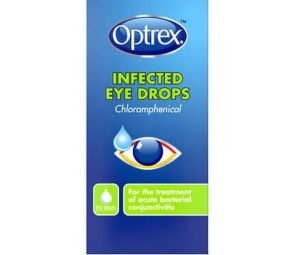Chloramphenicol has been in and out of stock in recent months. Do we have a chloramphenicol shortage? How does it affect the price of over the counter chloramphenicol eye drops?
Table of Contents
What is chloramphenicol?
Chloramphenicol is an antibiotic medication used to treat various bacterial infections. In the UK chloramphenicol is mainly used for the treatment of superficial eye infections (conjunctivitis) but also has a licensing for the treatment of otitis externa (inflammation of the external ear canal). Read more about the treatment of conjunctivitis with chloramphenicol eye drops.
Chloramphenicol: different forms and licensing
Chloramphenicol is available in different forms, although from the public perspective chloramphenicol eye drops and eye ointment are the most accessible:
- Chloramphenicol 0.5% eye drops (pharmacy-only medicines): available for the public to buy in pharmacies. Chloramphenicol eye drops are sold as generic drops or as branded eye drops, for example, Optrex Infected Eye, Brolene Antibiotic 0.5%w/v Eye Drops.
- Chloramphenicol 0.5% eye drops, prescription-only medicine (POM). Some generic chloramphenicol eye drops are only used for prescriptions. These do not differ from chloramphenicol eye drops sold to the public.
- Chloramphenicol 1.0% Antibiotic Eye Ointment – generic, pharmacy-only ointment, which is available for the public to buy, also available as branded medicines, for example, Optrex Bacterial Conjunctivitis 1% Eye Ointment.
- Eykappo (Chloramphenicol) 5mg/ml Eye Drops, a preservative-free eye drops, licensed only as a prescription-only medicine.
- Minims Chloramphenicol 0.5% eye drops solution, a prescription-only, preservative-free chloramphenicol eye drops, which come in single-use vials
Can you buy chloramphenicol 0.5% eye drops over the counter?
Chloramphenicol 0.5% eye drops can be purchased over the counter. chloramphenicol 0.5% eye drops are classified as pharmacy-only medicines, which means the sale of drops is restricted to pharmacies. Chloramphenicol 0.5% eye drops are not available for public self-selection, which means customers need to ask a member of the pharmacy team for assistance.
Over the counter chloramphenicol 0.5% eye drops and ointment can be used by adults and children over 2 years of age.
Chloramphenicol shortage
In the last couple of years, pharmacy has seen shortages of many common drugs. Most recently atorvastatin shortage affected many patients in the UK. Chloramphenicol was not spared. At the peak of the chloramphenicol shortage, no chloramphenicol eye drops or eye ointments were available to buy or for prescriptions. Although today, the availability of chloramphenicol eye drops and ointment has improved, the chloramphenicol shortage left some significant effects on the pricing of both medicines.
Chloramphenicol shortage: pricing issues
Manufacturers and wholesalers take advantage of ‘shortage’ situations, increasing the prices, which fluctuate on a daily/weekly basis. At the peak of the chloramphenicol shortage, chloramphenicol eye drops were priced around £10 (wholesaling price), which means pharmacies, priced over the counter eye drops around £16-£18, with some pharmacies charging even £20. Today, if priced correctly one should expect to pay around £11.
Chloramphenicol eye ointment is generally cheaper to buy.
Frequent changes in wholesaling prices also affected the supply of both eye drops and eye ointment on prescription since supplying pharmacies made a loss on each supply.
Chloramphenicol eye drops vs chloramphenicol eye ointment
Chloramphenicol eye drops come in liquid form and are typically presented in small plastic dropper bottles. They are instilled directly into the eye using the dropper. The drops are applied as a thin layer and quickly spread over the surface of the eye when blinking.
How chloramphenicol eye drops are applied?
Chloramphenicol eye ointment is a semi-solid, greasy substance. It is usually applied as a small amount inside the lower eyelid (lower conjunctival sac). When the patient blinks, the ointment spreads across the surface of the eye. Unlike eye drops, it remains on the eye surface for a more extended period.
How chloramphenicol eye drops are used?
One drop is instilled into the infected eye every 2 hours for the first 48 hours and 4 hourly thereafter. Eye drops are used during waking hours only. Treatment should continue for 5 days, even if symptoms improve (emc, 2023).
How chloramphenicol eye ointment is used?
A small amount of ointment (about 1cm) to be applied to the affected eye(s). The ointment should be applied either at night if eye drops are used during the day, or 3 to 4 times a day if eye ointment is used alone (ibid).
Conclusion
Chloramphenicol shortage has had a significant impact on the availability and affordability of this antibiotic. With limited supply, the price of chloramphenicol has soared, making it more financially burdensome for patients and problematic supply to fulfil the prescriptions since reimbursement price (the price paid for the cost of the drug by NHS) was not favourable at all times.
References
emc (2023). Chloramphenicol 5% w/v Ear Drops. Available at: https://www.medicines.org.uk/emc/product/3529/smpc Accessed on 06/08/2023
emc (2023). Optrex Bacterial Conjunctivitis 1% w/w Eye ointment. Available at: https://www.medicines.org.uk/emc/product/7299/smpc Accessed on 06/08/2023





